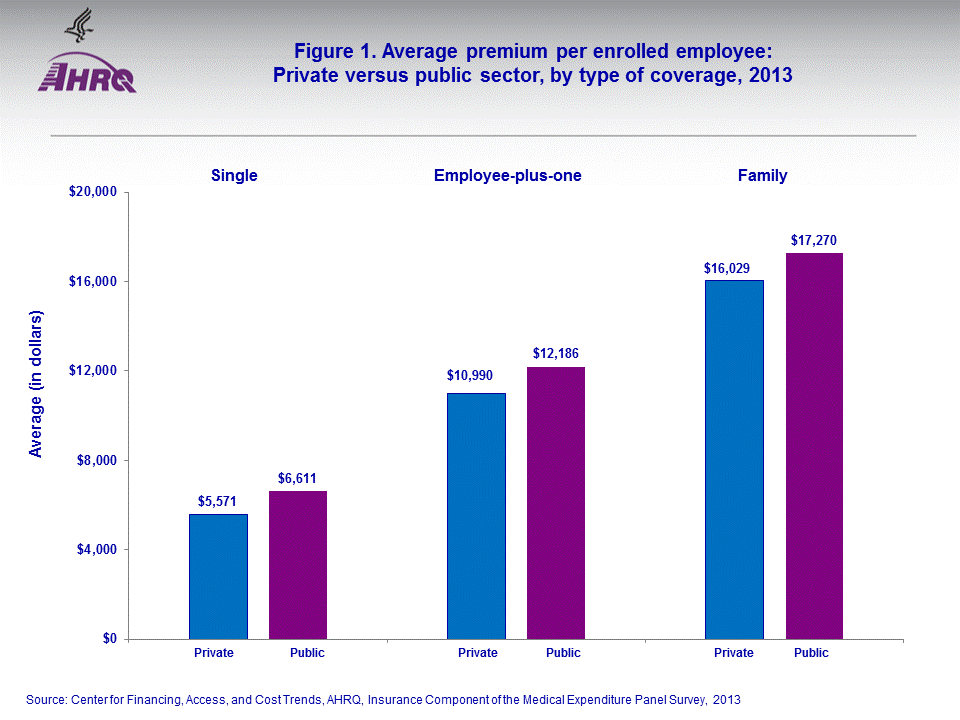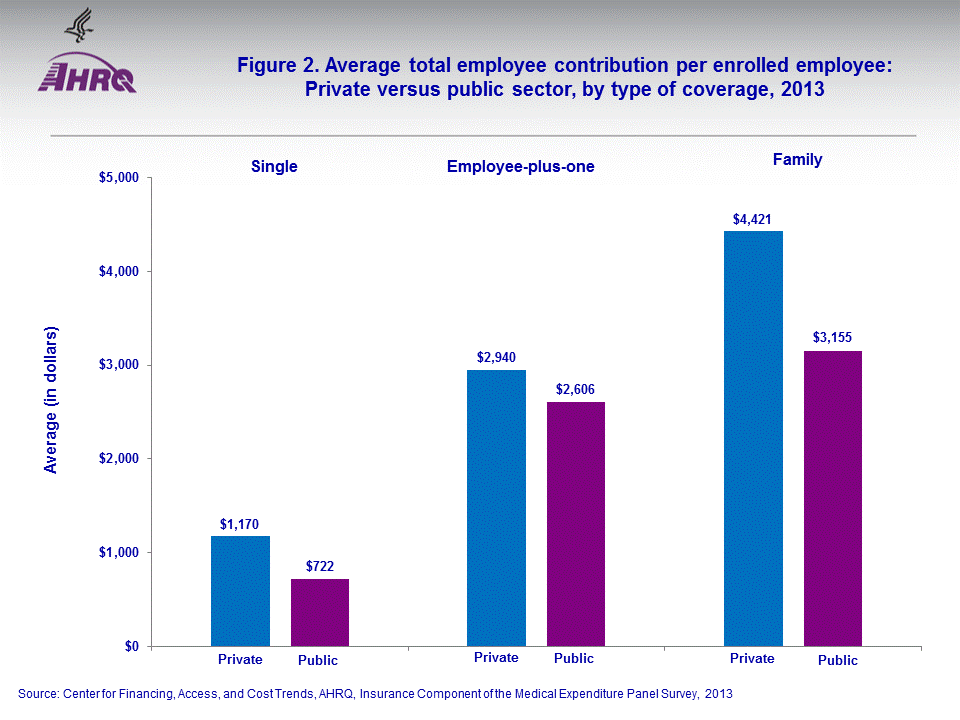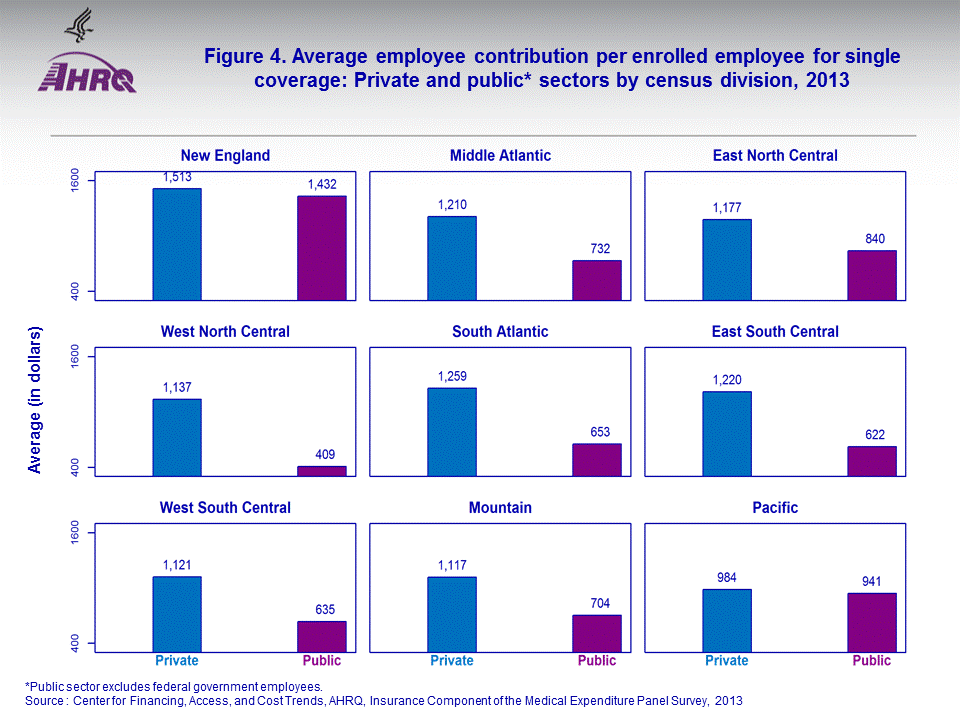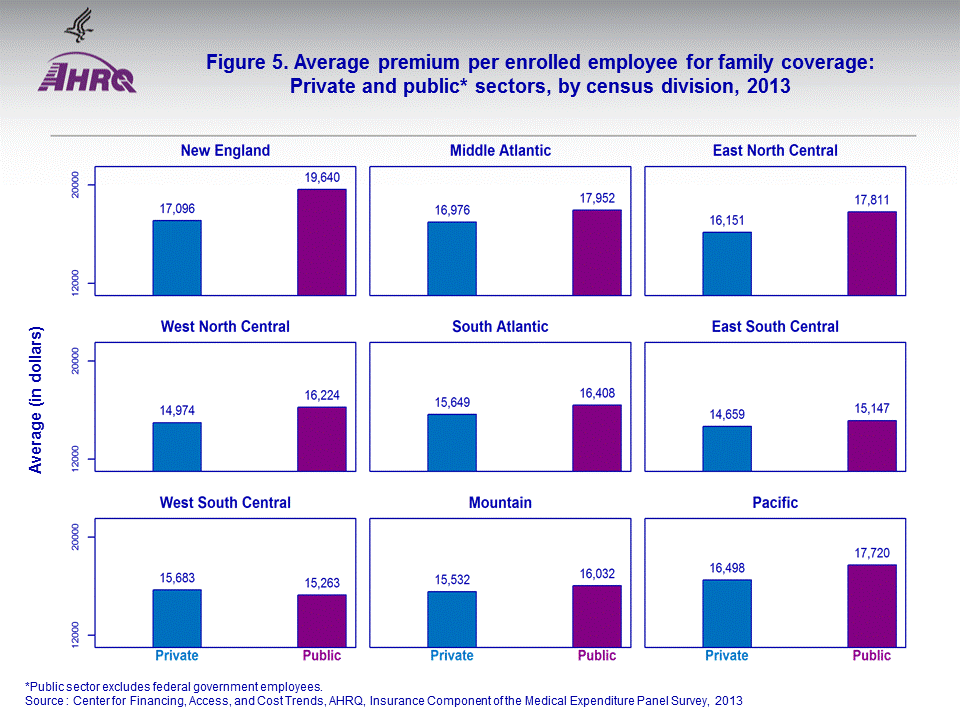
|
|
Font Size:
|
||||
|
|
|
|
||||
STATISTICAL BRIEF #474:
Premiums and Employee Contributions for Employer-Sponsored Health Insurance: Private versus Public Sector, 2013
Highlights
- In 2013, the average public (State/local governments) sector premiums for single, employee-plus-one, and family coverage were all higher than those for the private sector, with wide variations across geographic areas.
- Across both the public and private sectors, the highest average health insurance premiums in 2013 were for public sector employees for single coverage in the Pacific census division ($7,769) and for family coverage in the New England division ($19,640).
- Across both the public and private sectors, the lowest average health insurance premiums in 2013 for single coverage ($5,158) and family coverage ($14,659) were for private sector employees in the East South Central division.
- On average, public sector employee contributions for family coverage were lower than those for the private sector in all census divisions with the exception of West South Central.
Introduction
Employer-sponsored health insurance for current employees is one of the primary sources of health insurance coverage in the United States. According to data from the Insurance Component of the 2013 Medical Expenditure Panel Survey (MEPS-IC), approximately 115.7 million of the 133.0 million employees in the United States worked where the employer offered health insurance. U.S. civilian employees include those employed in the private sector and in the public sector (State and local, but not federal employees). Of those employees who worked where health insurance was offered, approximately 34.8 million were enrolled in single coverage, 13.0 million were enrolled in employee-plus-one coverage, and 21.4 million were enrolled in family coverage (data not shown).This Statistical Brief presents estimates, using 2013 MEPS-IC data, of average premiums and employee contributions for single, employee-plus-one, and family coverage. Estimates are for public and private sector employees who worked for entities that offered health insurance, and were enrolled in offered health insurance plans. Estimates by census geographic division are also presented for average premiums and employee contributions for single and family coverage for enrollees in both the public and private sectors. Only comparisons that had a statistically significant difference at the 0.05 percent significance level are noted in the text.
Findings
Premiums in 2013 (figure 1)Among the 133.0 U.S. million civilian employees who worked for private or public sector employers in 2013, 87.0 percent worked where the employer offered health insurance and 59.8 percent of these were enrolled in a plan (estimates not shown in figures). The average public sector premiums in 2013 were $6,611 for single coverage, $12,186 for employee-plus-one coverage, and $17,270 for family coverage (figure 1). For the private sector, these averages were $5,571, $10,990, and $16,029, respectively.
Employee contributions in 2013 (figure 2)
Public sector employees contributed an average of $722 for single coverage, $2,606 for employee-plus-one coverage, and $3,155 for family coverage to their health insurance premiums in 2013 (figure 2). These averages were all lower than those for private sector employees ($1,170, $2,940, and $4,421, respectively).
Private and public health insurance coverage variations by census geographic division, 2013 (figures 3–7).
In 2013, average annual premiums and employee contributions varied substantially across both public and private sector employers and by geographic divisions as summarized below:
- Public sector premiums for single coverage were higher in all census divisions than those for the private sector in 2013 (figure 3). Average annual health insurance premiums per enrolled civilian employee with single coverage ranged from $5,158 for private sector employees in East South Central to $7,769 for public sector employees in Pacific.
- Public sector employee contributions toward single coverage were lower than those for the private sector in all census divisions, except for New England and Pacific (figure 4). Average employee contributions per enrolled civilian employee with single coverage ranged from $409 for public sector employees in West North Central to $1,513 for private sector employees in New England in 2013.
- Public sector premiums for family coverage were higher than those for the private sector in all census divisions, except for West South Central in 2013 (figure 5). Average annual health insurance premiums per enrolled civilian employee with family coverage ranged from $14,659 for private sector employees in East South Central to $19,640 for public sector employees in New England.
- Public sector employee contributions toward family coverage were lower than those for the private sector in all census divisions, except for West South Central (figure 6). Average employee contributions per enrolled civilian employee with family coverage ranged from $1,897 for public sector employees in Middle Atlantic to $5,152 for public sector employees in West South Central in 2013.
- In 2013, the percentage of premium paid per enrolled employee for family coverage was lower in the public sector for all census divisions except West South Central (figure 7). The percentage of premium paid toward family coverage ranged from 10.6 percent for public sector employees in Middle Atlantic to 33.8 percent for public sector employees in West South Central.
Data Source
This Statistical Brief summarizes data from the 2013 MEPS-IC. The data are available on the MEPS Web site at http://www.meps.ahrq.gov/mepsweb/survey_comp/Insurance.jsp or have been produced using special computation runs on the confidential MEPS-IC data available at the U.S. Census Bureau.Definitions
States were grouped into nine census divisions as follows:- New England: Connecticut, Maine, Massachusetts, New Hampshire, Rhode Island, Vermont
- Middle Atlantic: New Jersey, New York, Pennsylvania
- East North Central: Illinois, Indiana, Michigan, Ohio, Wisconsin
- West North Central: Iowa, Kansas, Minnesota, Missouri, Nebraska, North Dakota, South Dakota
- South Atlantic: Delaware, District of Columbia, Florida, Georgia, Maryland, North Carolina, South Carolina, Virginia, West Virginia
- East South Central: Alabama, Kentucky, Mississippi, Tennessee
- West South Central: Arkansas, Louisiana, Oklahoma, Texas
- Mountain: Arizona, Colorado, Idaho, Montana, Nevada, New Mexico, Utah, Wyoming
- Pacific: Alaska, California, Hawaii, Oregon, Washington
Civilian employees include those employed in the private sector and in the public (State/local government) sector. Federal government employees, postal workers, military, and unincorporated self-employed individuals with no employees are not included.
Employee-plus-one coverage
Health insurance that covers the employee and one other family member at a lower premium level than family coverage. For the MEPS-IC survey, if premiums are different for employee-plus-spouse and employee-plus-child coverage, the costs for employee-plus-child coverage are collected.
Family coverage
Health insurance that covers the employee and one or more members of his/her immediate family (spouse and/or children as defined by the plan). For the MEPS-IC survey, “family coverage” is any coverage other than single and employee-plus-one. Some plans offer more than one rate for family coverage, depending on family size and composition. If more than one rate is offered, survey respondents are asked to report costs for a family of four.
Premium
Agreed upon fees paid for coverage of medical benefits for a defined benefit period. Premiums can be paid by employers, unions, employees, or split between the insured individual and the plan sponsor.
Single coverage
Health insurance that covers the employee only. This is also known as employee-only coverage.
About MEPS-IC
The MEPS-IC is a survey of business establishments and governments that collects information on employer-sponsored health insurance, such as whether insurance is offered, enrollments, types of plans, and premiums. The survey is conducted annually by the U.S. Census Bureau under the sponsorship of the Agency for Healthcare Research and Quality (AHRQ). A total sample of approximately 42,000 private sector establishments was selected for the 2013 survey with 6.7 percent of the sample determined to be out-of-scope during the data collection process. The response rate for the private sector was 74.6 percent of the remaining in-scope sample units. For State and local governments, a sample of approximately 3,100 governmental units was selected with a response rate of 88.6 percent.For more information on this survey, see MEPS Methodology Reports 6, 8, 10, 14, 17, 18, 27, and 28 and the MEPS-IC Technical Notes and Survey Documentation, which are available on the MEPS Web site (http://meps.ahrq.gov/mepsweb/).
Suggested Citation
Davis, K. Premiums and Employee Contributions for Employer-Sponsored Health Insurance: Private versus Public Sector, 2013. Statistical Brief #474. June 2015. Agency for Healthcare Research and Quality, Rockville, MD. http://www.meps.ahrq.gov/mepsweb/data_files/publications/st474/stat474.shtmlAHRQ welcomes questions and comments from readers of this publication who are interested in obtaining more information about access, cost, use, financing, and quality of health care in the United States. We also invite you to tell us how you are using this Statistical Brief and other MEPS data and tools and to share suggestions on how MEPS products might be enhanced to further meet your needs. Please email us at MEPSProjectDirector@ahrq.hhs.gov or send a letter to the address below:
Steve B. Cohen, PhD, Director
Center for Financing, Access, and Cost Trends
Agency for Healthcare Research and Quality
540 Gaither Road
Rockville, MD 20850
 |
||||||||||||||||||||||||||||||||||||
|
||||||||||||||||||||||||||||||||||||
|
|
||||||||||||||||||||||||||||||||||||
 |
||||||||||||||||||||||||||||||||||||
|
||||||||||||||||||||||||||||||||||||
|
|
||||||||||||||||||||||||||||||||||||
 |
||||||||||||||||||||||||||||||||||||
|
||||||||||||||||||||||||||||||||||||
|
|
||||||||||||||||||||||||||||||||||||
 |
||||||||||||||||||||||||||||||||||||
|
||||||||||||||||||||||||||||||||||||
|
|
||||||||||||||||||||||||||||||||||||
 |
||||||||||||||||||||||||||||||||||||
|
||||||||||||||||||||||||||||||||||||
|
|
||||||||||||||||||||||||||||||||||||
 |
||||||||||||||||||||||||||||||||||||
|
||||||||||||||||||||||||||||||||||||
|
|
||||||||||||||||||||||||||||||||||||
 |
||||||||||||||||||||||||||||||||||||
|
||||||||||||||||||||||||||||||||||||
|
|
||||||||||||||||||||||||||||||||||||


